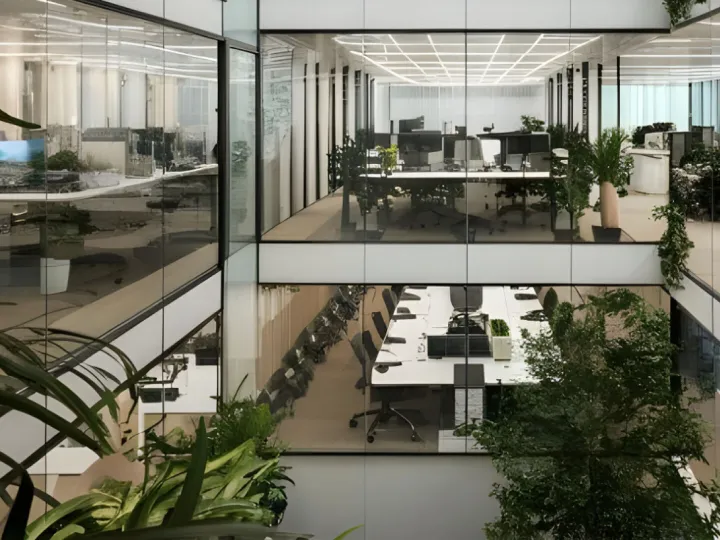Biophilic design in office fit outs
Understanding biophilic design basics
In recent years, the term biophilic design has grown from niche interior rhetoric to a credible framework for high-performing workspaces. At its core, it recognises humans’ innate affinity with nature – the biophilia hypothesis – and seeks to translate that into built environments by incorporating natural light, plant life, natural materials, views to nature, and sensory connections to the outside world.
For a business considering an office fit-out or refurbishment, this means more than adding a few potted plants or timber veneer panels. The strategy must be integrated, from reviewing the building’s orientation and glazing to reconsidering HVAC systems, lighting controls, and material choices. Maximising daylight through large windows or glazed partitions reduces reliance on electric lighting, aligns with circadian rhythms, and improves alertness while reducing fatigue.
Moreover, natural materials such as stone, wood, bamboo, or even recycled textiles contribute tactile warmth and sensory richness, which contrast favourably with the ubiquitous exposed concrete and metal finishes of many modern offices. This use of texture and organic form also has subtle psychological benefits; it reintroduces calm, variety and subconscious cues of nature into an interior. By understanding these mechanics, one can see that a biophilic fit-out is not just decorative: it’s an architectural and technical approach with measurable outcomes for people and business performance.
Business benefits of biophilic design
From a business owner or C-suite perspective, the real question becomes: what returns do you gain from investing in biophilia as part of your office upgrade? The evidence is compelling. One of the most significant benefits is enhanced productivity and cognitive function. Offices with biophilic design features could yield productivity increases, reduced stress and improved wellbeing among employees, greater mood stability and improved concentration.
A further dimension is operational cost efficiency. Improving daylight access, harnessing natural ventilation, and reducing artificial lighting hours all contribute to lower energy consumption and lower HVAC loads. Biophilic lighting strategies can cut reliance on artificial lighting and reduce energy costs.
In terms of brand and recruitment, the benefits are far from trivial. In a world where talent retention and employer branding matter ever more, a thoughtfully designed office communicates care, sustainability and employee-centred culture. Employees report higher job satisfaction when working in spaces with natural elements; businesses report reduced absenteeism and improved retention.
In short, for businesspeople looking to refurbish or upgrade their workplace, embedding biophilic design is not simply a cosmetic choice but a strategic one that affects staff wellbeing, productivity, costs, and brand reputation.
Technical considerations for implementation
When it comes to taking action on a biophilic office fit-out, the technical details must be carefully managed to ensure that design intent aligns with performance outcomes.
Daylight and glazing design: To maximise natural light penetration, consider building orientation, location of workstation zones relative to window lines, and choice of glass (low-iron, high transparency, low-glare coatings). Use of glazed internal partitions can allow daylight to filter deeper into the plan, benefiting inner areas, and reduce reliance on artificial lighting. Specify lax-glare sensors and dimming controls to tie artificial lighting to daylight levels.
Indoor air quality and ventilation: Incorporating plants, living walls, green ceilings, or planting zones can support improved indoor air quality, humidity moderation, and toxin filtration. For example, a UK review found that indoor plants can help reduce nitrogen dioxide levels. But plants alone are not sufficient; ventilation systems should be designed to bring fresh air, minimise stale zones, and use CO₂ monitoring to ensure optimal occupant health.
Materials and finishes: Choose sustainably sourced natural materials (wood, stone, bamboo, cork) and avoid heavy reliance on synthetic finishes with high volatile organic compound (VOC) content. These materials add warmth, tactile interest and help connect occupants to nature. Research shows that the use of biomorphic shapes, timber walls, and woven natural fabrics can reduce visual fatigue and support wellbeing.
Acoustics and noise control: In many open-plan offices, the challenge is not only the visual environment but the sound environment. Biophilic design can help here too: green walls, planted ceilings, natural textures and soft furnishings all contribute to absorbing sound and reducing reverberation. Studies show that workers in nature-rich spaces report fewer distractions and better focus.
Thermal comfort and technical integration: Natural lighting and large glazing areas mean more potential for heat gain or loss. It is vital to integrate smart HVAC controls, shading systems (e.g., solar-control glazing, blinds, external shading), and thermal modelling into the planning stage. A well-executed biophilic office must be comfortable year-round, not just visually pleasing. The sustainable fit-out guidance emphasises programmable thermostats, high-efficiency systems, and biophilic elements.
Phasing and budget planning: Many businesses cannot undertake a wholesale fit-out overnight. It is practical to implement biophilic elements in phases: start with reception and breakout zones, where visibility is high, then extend to workstations and ancillary spaces. According to the tenant-perspective research, phasing allows budget controls and a smoother transition.
In sum, a successful biophilic office fit-out demands coordination between architectural/engineering teams, interior designers and facilities management. Neglecting the technical implementation will under-deliver on the promise of biophilia.
Practical advice for office upgrades
For businesspeople planning an office upgrade, here are pragmatic insights to ensure the biophilic strategy delivers real value.
First, begin with a clear brief that ties the fit-out to business objectives: employee retention, brand positioning, productivity, sustainability credentials, or cost savings. When biophilic design is framed as aligned with those goals, it becomes easier to secure leadership buy-in and budget approval.
Second, perform a baseline audit of the existing space, including daylight levels, air quality, circulation patterns, current materials, acoustics and staff sentiment. Understanding the current state enables the setting of measurable targets and demonstrates ROI post-implementation.
Third, engage a fit-out partner with proven experience in biophilic design. Not all interior contractors or designers have worked systematically with nature-led workplaces. Look for case studies where the partner has integrated technical systems, environmental modelling and occupant metrics.
Fourth, communicate with your workforce. A refurbishment disrupts daily operations, but when employees understand what is happening and why – that the new space will help them feel better, focus more and connect better – you build engagement and ownership. Some organisations invite staff to contribute to plant choices.
Fifth, ensure measurement and iteration. Set up post-occupancy evaluation: how many sick days changed? What is the occupant satisfaction score? Did lighting consumption reduce? Did absenteeism drop? Being able to attribute the fit-out to improved results strengthens the business case and supports future upgrades.
Lastly, think long-term. Biophilic design is not a one-time improvement but a sustainable way of working. Choose materials and systems that can adapt as the organisation evolves. Consider modular furniture, flexible layouts and green elements that can be upgraded or expanded. This future-proofing ensures you won’t be locked into a static design as hybrid working patterns, technology and workforce expectations continue to shift.
Where nature meets business strategy
In an era where the role of the office is shifting from purely functional to strategic – a hub for collaboration, culture, creativity and brand experience. The choice of how you refurbish or upgrade your workspace becomes a business decision. Incorporating biophilic design is an excellent way to ensure the space not only looks good but also works harder: enhancing wellbeing, performance, sustainability, and brand equity.
For business leaders and decision-makers, the message is clear: don’t treat nature-inspired elements as optional extras or as a sign of lavishness. See them as integral to your workplace strategy, aligned with your people, your brand and your ambition. By committing to technical rigour, thoughtful implementation and measurement, you will transform your office into an environment where people thrive and business flourishes.

